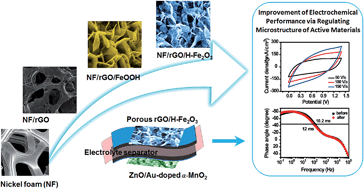Ultrafast charge/discharge solid-state thin-film supercapacitors via regulating the microstructure of transition-metal-oxide†
Abstract
Supercapacitors based on transition-metal-oxide (TMO) offer an attractive option owing to their high energy densities, low cost of materials, high abundance, environmental-friendliness and corrosion-resistance. Despite extensive research efforts, the development of TMO-based supercapacitors still falls short of the expectations largely because of their poor conductivity, low rate capability and charge/discharge characteristics. Here, a solid-state thin-film asymmetric supercapacitor (ASC) based on highly conductive TMO was fabricated by regulating the microstructure of electrode materials. This design minimizes the electronic and ionic resistance and produces an ASC with ultrafast rate capability (up to 150 V s−1) and fast frequency response (relaxation time constant τ0 = 10.2 ms), which substantially surpasses the previously reported values for solid-state TMO-based supercapacitors and most carbon-based flexible micro-supercapacitors. Furthermore, the state-of-the-art ASC demonstrates long cycle stability (97% of capacitance retention after 10 000 cycles), high energy density (0.14 mW h cm−3) and power density (12.30 W cm−3), which are comparable with those of certain commercial supercapacitors and carbon-based micro-supercapacitors.



 Please wait while we load your content...
Please wait while we load your content...